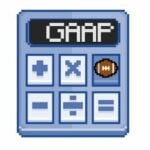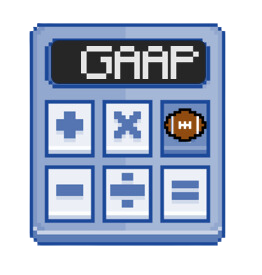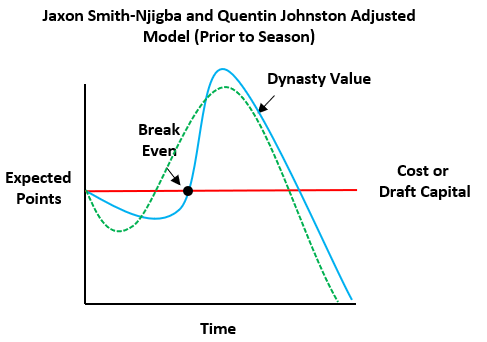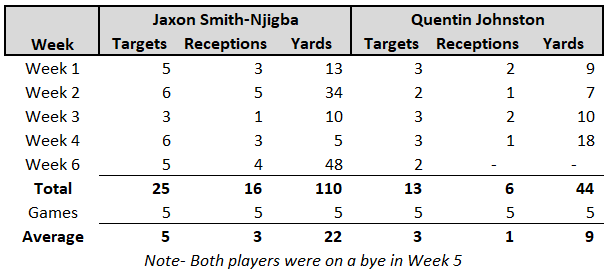Dynasty GAAP Memo: Jaxon Smith-Njigba and Quentin Johnston
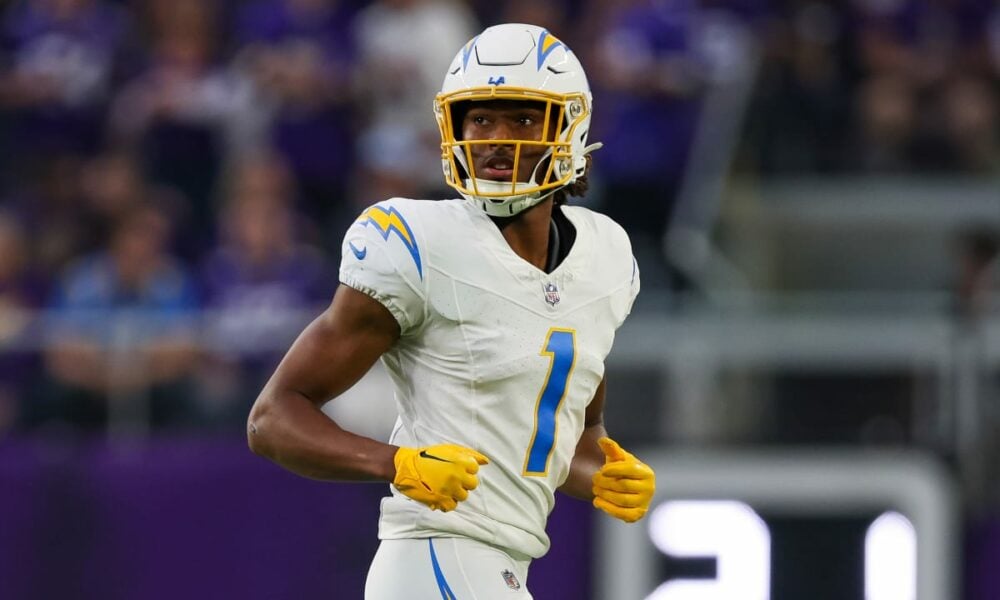
I am a CPA who fits the typical accountant stereotype. I enjoy writing technical accounting memos, accounting research (yes, it’s a thing), and analyzing the financial statements of a business. In accounting, you often must evaluate qualitative and quantitative factors during complex transactions to forecast future performance. I have found that the outlook and rationale of evaluating business transactions parallels another interest of mine, dynasty fantasy football.
In dynasty, we are given both quantitative factors (athletic scores, draft capital, college production, etc.) and qualitative factors (camp hype, team situation, injury history, etc.) that we must consider and evaluate to derive an estimate or projection of a player. Then, we must take calculated risks based on our team’s overall financial statements (i.e., current roster and league). I could go on and on with accounting-based puns and comparisons, but I think you get it.
I will note that I will write in the form of “accounting memos.” For anyone who has not been exposed, the format is very standard. Each memo will start with the “purpose.” Next, it will outline the applicable “guidance” or accounting literature utilized and supply background. Last will be the analysis and conclusion. The goal is to state the issue and quickly address it. My write-ups will follow this same logic.
To summarize, welcome to “Good at Analyzing Players” or “GAAP”. And yes, this is a play on “Generally Accepted Accounting Principles” and my wife did come up with it.
Purpose
The purpose of this memo is to evaluate the break-even point on Jaxon Smith-Njigba and Quentin Johnston, who were both first round draft picks that have underperformed thus far in their rookie season.
Background
Fantasy managers must always fight immediate gratification with rookie players. This bias is created by our innate tendency to seek instant rewards or pleasures over delaying the same gratification over time. Over the last few fantasy seasons, this bias has only grown because rookie wide receivers are transitioning faster and producing quicker in the season than ever before. In 2014, Odell Beckham Jr. went for 1,305 receiving yards as a rookie which was the best since Anquan Boldin in 2003 who had 1,377 receiving yards. In 2020, Justin Jefferson erupted for 1,400 receiving yards only to be followed up by Jamar Chase a year later with 1,455 receiving yards. In 2022, managers saw both Chris Olave and Garrett Wilson go over 1,000 yards receiving. These stats were not always the case. The standard used to be the year 2 and year 3 breakouts and patience was always coached on rookie wide receivers.
Ironically, neither of the first two wide receivers taken in the 2023 NFL draft have surpassed 48 receiving yards five games into their rookie seasons. These wide receivers are Jaxon Smith-Njigba (“Smith-Njigba”), Seattle Seahawks, and Quentin Johnston (“Johnston”), Los Angeles Chargers, who were taken 20th and 21st overall in the NFL Draft.
These two players were drafted in real life and by fantasy managers with 2024 in mind as both had established veterans in front of them on the depth chart. This memo will evaluate their value and if we anticipate them to break even based upon the draft capital spent on them.
Resources
● Sleeper: Great interface for looking up historical statistics
● DLF Dynasty Rankings: Best Dynasty Rankings in the Industry
● DLF Average Draft Position (“ADP”) Data: Best resource to gauge current player value. Based upon real Dynasty Startups.
Analysis
In dynasty and business, the goal should always be to break even or make a profit on every transaction, trade, draft pick, or waiver claim. However, profit in dynasty is a little bit more nuanced than business. The following situations could all be considered profitable transactions given the context:
● Drafting Puka Nacua in the 3rd or 4th round of your 2023 rookie drafts.
● Trading a first-round rookie pick for a veteran on the wrong side of 30 to eventually win a dynasty championship.
● Selling an elite fantasy producer, like Tyreek Hill, on a rebuilding roster for a first and second round rookie pick because your league is stingy and no one trades, but you need to get the 27 fantasy points per game out of your lineup.
The good news is that the two players being discussed in this memo are young, have first round NFL draft capital, elite athletic traits, and play the most sought-after position in dynasty (outside of QB in Superflex). If X (formerly Twitter) and Reddit are any indication, saying that managers are concerned over their performance thus far would be an understatement.
In accounting, there is a concept of a breakeven point. The breakeven point is the level of production at which the costs of production equal the revenues for a product. Thus, to be profitable, managers need the production (and accompanying dynasty value) to be above the breakeven point long term. The table below is a graphical depiction of this concept applied to dynasty.
The image above is how the graph would look in an ideal state. After players become rookie picks, players begin to depreciate until we expect fantasy points. After we get more confident in their ability to score their expected points grow so does their dynasty value. Over time their dynasty value depreciates as the players age. However, our cost to acquire the player does not change. For the sake of this memo, this will be the standard break-even model for dynasty players.
Adjustment Factors
Our expectations and the corresponding breakeven point for Smith-Njigba and Johnston were adjusted based on the factors below:
- Veteran Competition:
The Seahawks and Chargers both field one of the best veteran wide receiver cores in the NFL with DK Metcalf and Tyler Lockett and Keenan Allen and Mike Williams, respectively. The narrative heading into the season was that both Smith-Njigba and Johnston might take time to produce. Which shifted the ‘breakeven point’ towards the middle or later into the season.
- High Ceiling:
While managers knew that they might have to wait on fantasy points based upon the consideration above, most were excited to invest in these rookies due to the elite characteristics that each of them possessed.
Jaxon Smith-Njigba:
- Breakout Age: 19.6 years old (75th Percentile)
- Burst Score: 122.0 (55th Percentile)
- Agility Score: 10.50 (99th Percentile)
- College Stats (Ohio State):
- 2020: 10 Receptions; 49 Yards; 1 TDs
- 2021: 95 Receptions; 1,606 Yards; 9 TDs
- 2022: 5 Receptions; 43 Yards; 0 TDs (Injured and only played three games)
- Other Considerations:
- Seattle has been a longtime producer at fantasy and has often been able to support multiple top 24 WRs.
- Geno Smith was coming off a breakout season in 2022.
- Tyler Lockett is on the wrong side of 30 and perceived to be on the decline.
- Out-produced dynasty darlings in college (Garrett Wilson and Chris Olave) while on the same team.
Quentin Johnston:
- Breakout Age: 19.0 years old (89th Percentile)
- Burst Score: 135.9 (98th Percentile)
- Agility Score: 11.59 (14th Percentile)
- College Stats (TCU):
- 2020: 22 Receptions; 487 Yards; 2 TDs
- 2021: 33 Receptions; 612 Yards; 6 TDs
- 2022: 60 Receptions; 1,069 Yards; 6 TDs
- Other Considerations:
- Linked to a young premier passing QB in Justin Herbert
- Keenan Allen and Mike Williams have massive cap hits in 2024.
- Prototypical size at 6’ 3” and 208 lbs.
- Showed big play ability in college with 17.8 yards per reception in his final college season.
Adjusted Break-Even Model
When considering the athletic testing and measurables above as well as the opportunity and other situation inputs, these two prospects were identified as the highest ceiling amongst the four first round rookies. This is reflected in the graph below. Please note that the dotted green line is the standard.
The breakeven model indicates the expected breakeven point heading into the season. At this point, we should revisit this model based upon the additional data, which has not been great thus far. Smith-Njigba and Johnston’s performance five games into their rookie seasons has been abysmal. See the table below:
If we annualize or project these averages over a 17-game season, it gets even worse. See below:
We expected the break-even point would take longer than the standard timeline, so this should not be all that concerning. However, this is where the two prospects start to differ. Smith-Njigba still is competing with Lockett and Metcalf and dealt with a wrist injury during training camp. In comparison, Mike Williams tore his ACL in week three, which presented a huge opportunity for Johnston. The rookie has seen his snap share increase from around 25% to 50% but has yet to catch more than two footballs in a game. Therefore, the model above might still be indicative of Smith-Njigba’s break-even point. However, it is not for Johnston.
As the weeks go on without production, his expected fantasy points continue to decline which limits his dynasty value and potential ceiling. The assumption that managers were to be patient with him is starting to evaporate as he clearly has an opportunity and is not seizing it thus far. The model below indicates that his trajectory could be trending towards. It depicts that he is trending towards never being worth what it cost to acquire him. Please note that the dotted green line is the standard.
Conclusion:
For Jaxon Smith-Njigba, we need to fight the desire for immediate gratification. His performance thus far is what we expected. His current overall ranking on DLF is 22 and he is WR15. For me, the WR15 to WR18 range is spot on. The situation here might be to try and time the valley of the initial depreciation phase, which I think will be after the next couple of weeks. Buying at this point will maximize your rate of return. See below:
From a pricing perspective, I would be willing to pay a mid to late first or a player like Deebo Samuel who is producing to buy back years.
For Quenton Johnston, I am holding or trying to pivot if I can. Based on his performance up until this point, I do not think you are able to recoup the cost to acquire him in a first-round rookie pick. However, he is currently WR34 on DLF. If I could trade him for a more established player like Christian Kirk (WR36) or Diontae Johnson (WR35) or an ascending young player that I like way more Nico Collins (WR40), I would gladly get off the roller coaster and cash out (even if I have to pay a little bit on top). Otherwise, we must hold and wait for him to grow. In comparison to Smith-Njigba, Johnston was always a very raw prospect and needed to work on drops and body catches.
I have not dubbed him the next Kevin White or Jalen Reagor yet. However, through watching Addison Hayes videos, we know that from 2011 to 2021, 159 WRs were drafted on Day 1 and 2 of the NFL draft. Of those 159 players, 82 (51%) had less than 500 yards as a rookie. Of those 82, only 7 players 8.5% topped 750 yards in their sophomore season. Indicating that if Johnston does not start to produce soon, he will have to be an outlier to ever become fantasy viable. However, Amon-Ra St. Brown, currently WR5, did not break out until week 13 of his rookie season. Do not forget about his upside that his profile and opportunity still present and sell too low. In fact, you might kick the tires and offer a 2024 second for a manager who might be overreacting to the first five games of his career.
“I think any passing of judgment up until now was premature. He’s just getting going. We love him and he’s going to be a really big factor for us.”
- Dynasty GAAP Memo: Running Back Maturity Approach and Second-Year RBs - February 20, 2025
- Dynasty GAAP Memo: Post-Mortem Rookie Re-Draft - December 12, 2024
- Dynasty GAAP Memo: Buying The WR Dip Or Falling Knife? - November 14, 2024


